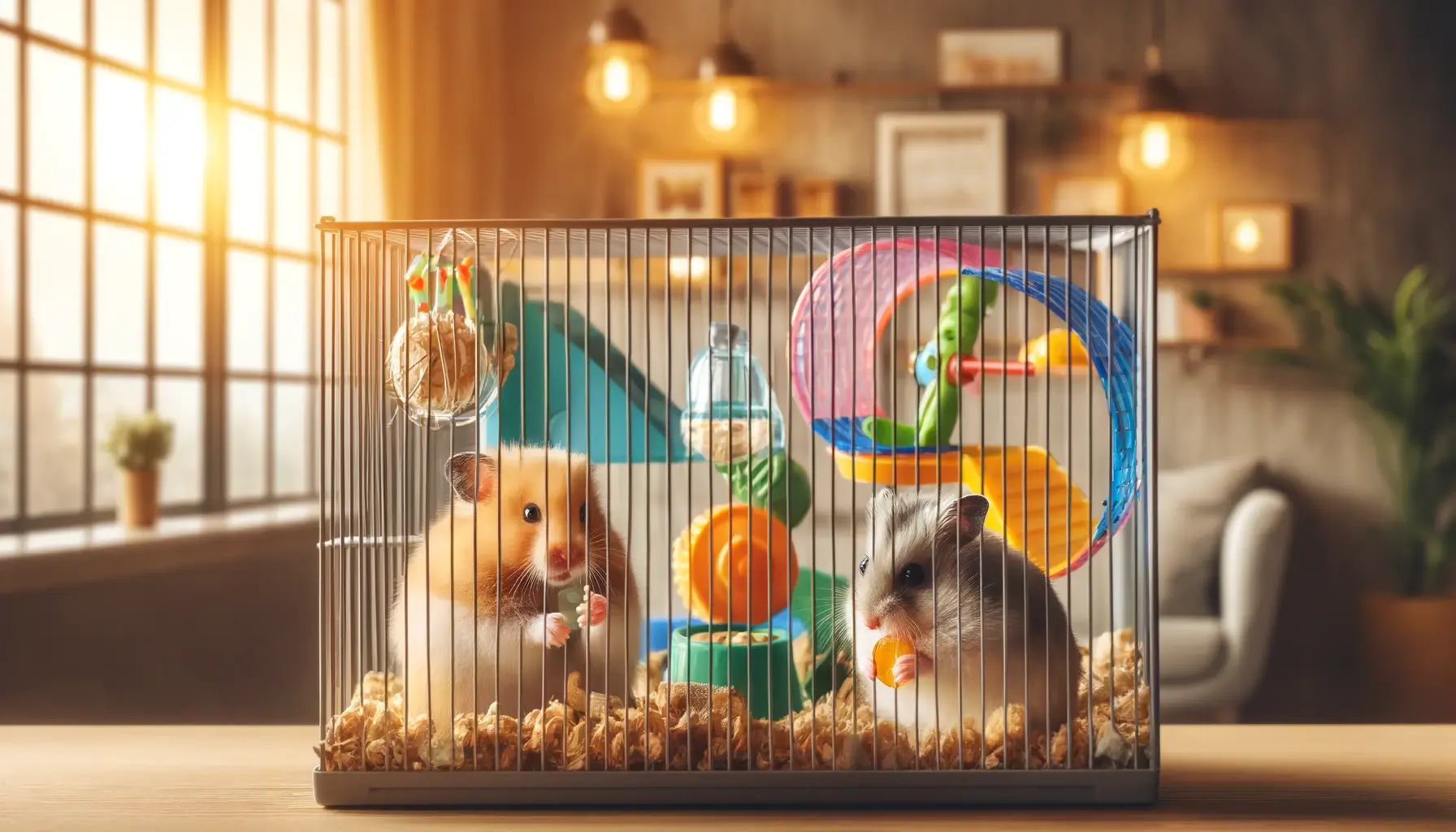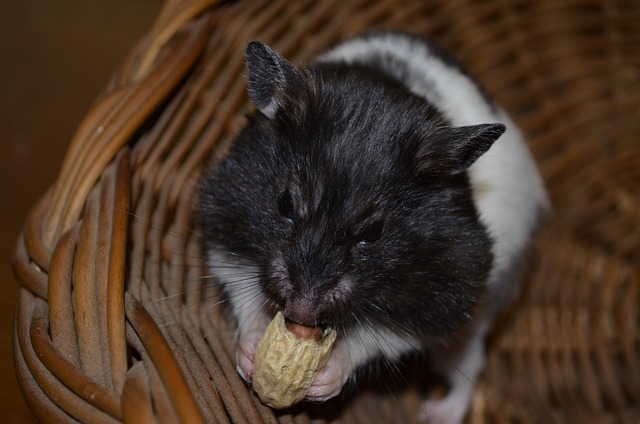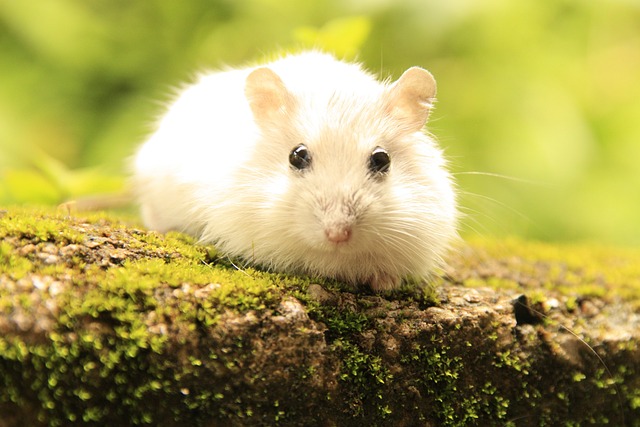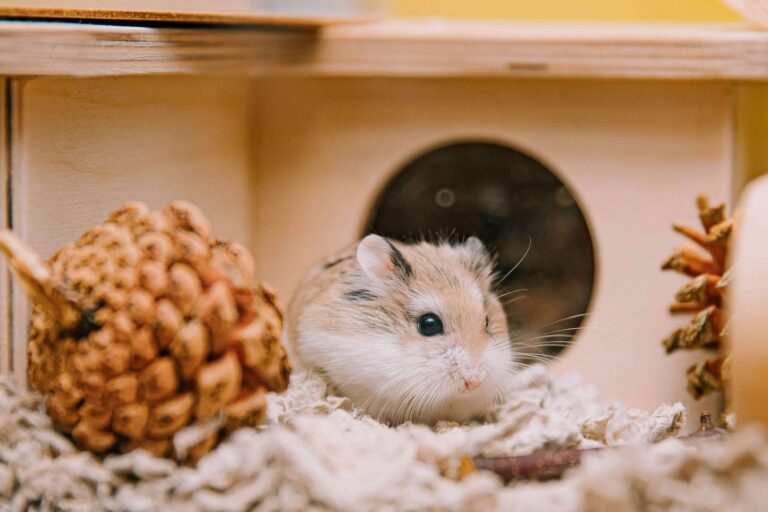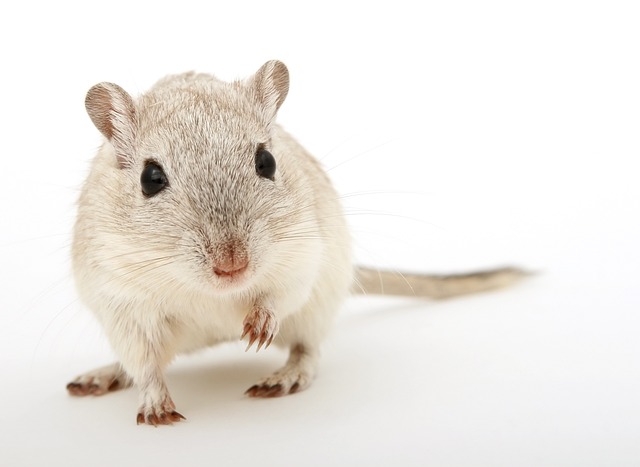Can 2 Hamsters Be In The Same Cage – Hamsters.pk
Understanding Hamster Behavior: Solitary vs. Social Species
When considering whether to house two hamsters together, it’s essential to understand the natural behavior and social tendencies of different hamster species. Hamsters can be broadly categorized into two groups: solitary and social species. Knowing which category your hamsters belong to will help you make an informed decision about their living arrangements.
Solitary Hamster Species
Most hamster species are solitary by nature, meaning they prefer to live alone. These species include:
- Syrian Hamsters (Mesocricetus auratus): Also known as Golden Hamsters, these are the most common pet hamsters. They are territorial and should always be housed individually.
- Chinese Hamsters (Cricetulus griseus): While they may tolerate same-sex siblings for a short period, they are best kept as solitary pets.
Solitary hamsters are highly territorial and will likely fight if housed together, leading to stress, injuries, and even death. In the wild, these hamsters only come together to mate and then go their separate ways.
Social Hamster Species
A few hamster species are known to be social and can potentially live together in pairs or small groups. These include:
- Dwarf Campbell’s Russian Hamsters (Phodopus campbelli): These small hamsters can sometimes coexist peacefully with same-sex littermates.
- Dwarf Winter White Russian Hamsters (Phodopus sungorus): Similar to Campbell’s, these hamsters may be able to live with same-sex siblings.
- Roborovski Hamsters (Phodopus roborovskii): The smallest of the pet hamster species, Roborovski hamsters can often live in same-sex pairs or small groups.
It’s important to note that even social hamster species have individual personalities, and not all will tolerate living with others. Close monitoring is necessary to ensure they are getting along well.
Signs of Aggression and Stress
When housing hamsters together, watch for signs of aggression and stress, such as:
- Fighting: Biting, chasing, or wrestling with each other aggressively.
- Excessive squeaking or screaming: Hamsters may vocalize loudly when feeling threatened or attacked.
- Food hoarding: Dominant hamsters may hoard food, preventing others from accessing it.
- Chasing and cornering: A hamster may chase and corner another, indicating bullying behavior.
If you observe any of these signs, it’s crucial to separate the hamsters immediately to prevent injury or death.

Conclusion
Understanding the natural behavior of your hamster species is the first step in determining whether they can live together. Solitary species like Syrians and Chinese hamsters should always be housed alone, while social species like Dwarf Campbell’s, Winter Whites, and Roborovski hamsters may be able to coexist under certain circumstances. However, even social species require close observation to ensure they are compatible and not displaying signs of aggression or stress. Ultimately, the well-being of your hamsters should be the top priority when making housing decisions.
Factors to Consider Before Housing Hamsters Together
When contemplating whether to house hamsters together, there are several crucial factors to consider. While some hamster species may be able to coexist peacefully, it’s essential to carefully evaluate various aspects of their care and well-being before making a decision. This article will explore the key factors to keep in mind when determining if housing hamsters together is a suitable option.
Hamster Species and Compatibility
The first factor to consider is the specific hamster species you have or plan to acquire. As discussed in the previous article, hamster species can be categorized as either solitary or social. Syrian hamsters and Chinese hamsters are solitary species that should always be housed individually. On the other hand, some dwarf hamster species, such as Dwarf Campbell’s Russian hamsters, Dwarf Winter White Russian hamsters, and Roborovski hamsters, may be able to live together under certain circumstances.
It’s important to remember that even within social species, individual personalities can vary greatly. Some hamsters may be more tolerant of living with others, while some may prefer a solitary life. Always monitor your hamsters closely for signs of aggression or stress, even if they are of a social species.
Same-Sex Pairs or Littermates
When attempting to house hamsters together, it’s crucial to ensure they are of the same sex to prevent unintended breeding. Female hamsters are generally more likely to coexist peacefully compared to males, who tend to be more territorial and aggressive.
Another factor to consider is whether the hamsters are littermates, meaning they were born and raised together. Littermates have a higher chance of getting along since they are already familiar with each other. However, even littermates can develop aggression towards one another as they mature, so constant monitoring is still necessary.
Age and Introduction Timing
The age at which you introduce hamsters to each other can also play a role in their compatibility. It’s generally easier to introduce young hamsters to each other, as they are more adaptable and less likely to have developed strong territorial behaviors. Introducing adult hamsters to each other can be more challenging and may require a more gradual process.
When introducing hamsters, it’s essential to do so in a neutral territory that neither hamster has previously occupied. This can help reduce territorial behavior and minimize the risk of aggression. It’s also crucial to monitor their interactions closely and separate them immediately if any signs of aggression or stress occur.
Cage Size and Enrichment
Providing an appropriately sized cage with ample space for each hamster is essential when housing them together. A larger cage allows hamsters to establish their own territories and minimize potential conflicts. As a general rule, the cage should be at least 620 square inches (4,000 square cm) for two dwarf hamsters.
In addition to a spacious cage, it’s crucial to provide multiple resources such as food bowls, water bottles, exercise wheels, and hiding spots. Having multiple resources can help reduce competition and minimize the likelihood of fights breaking out over access to these essentials.
Providing a variety of enrichment items such as tunnels, chew toys, and nesting materials can also help keep your hamsters mentally stimulated and reduce stress levels. Boredom and stress can lead to increased aggression, so a well-enriched environment is crucial for maintaining harmony between hamsters living together.
Monitoring and Separation
Even if you have carefully considered all the factors mentioned above and have successfully introduced your hamsters to each other, ongoing monitoring is essential. Regularly check for signs of aggression, stress, or injury, and be prepared to separate the hamsters if necessary.
It’s a good idea to have a spare cage set up and ready in case you need to separate your hamsters quickly. This will ensure that you can provide a safe environment for each hamster if their cohabitation is not working out.
Conclusion
Housing hamsters together can be a rewarding experience for both the hamsters and their owners, but it requires careful consideration and planning. By taking into account factors such as species compatibility, same-sex pairs, age, introduction timing, cage size, enrichment, and ongoing monitoring, you can create the best possible environment for your hamsters to thrive together. Remember, the well-being of your hamsters should always be the top priority, and separating them is necessary if they are not getting along peacefully.
Risks and Challenges of Keeping Multiple Hamsters in One Cage
While some hamster species may be able to live together under certain circumstances, housing multiple hamsters in one cage comes with various risks and challenges. It’s essential for hamster owners to be aware of these potential issues to ensure the well-being and safety of their pets. This article will explore the risks and challenges associated with keeping multiple hamsters in the same cage.
Aggression and Fighting
One of the most significant risks of housing multiple hamsters together is the potential for aggression and fighting. Even hamsters that have previously coexisted peacefully can suddenly develop aggressive behavior towards one another. Fights can occur for various reasons, such as competing for resources, establishing dominance, or simply due to individual personalities.
Hamster fights can be intense and violent, often resulting in serious injuries or even death. Common injuries from hamster fights include bite wounds, scratches, and fur loss. In some cases, a dominant hamster may continue to bully or harass a submissive hamster, causing chronic stress and impacting their overall health.
Stress and Anxiety
Living in close quarters with another hamster can be a significant source of stress and anxiety, even if the hamsters are not actively fighting. Hamsters are naturally solitary animals, and the constant presence of another hamster can be mentally taxing. Chronic stress can lead to a weakened immune system, making hamsters more susceptible to illnesses and health problems.
Signs of stress in hamsters include:
- Excessive grooming or hair loss
- Decreased appetite
- Lethargy or reduced activity levels
- Increased aggression or irritability
- Repetitive behaviors, such as pacing or bar-chewing
If you notice any of these signs in your hamsters, it may indicate that living together is causing them undue stress, and separating them may be necessary for their well-being.
Resource Competition and Hoarding
When multiple hamsters live in the same cage, there is an increased risk of competition for resources such as food, water, and nesting materials. Even if you provide multiple food bowls and water bottles, a dominant hamster may monopolize these resources, preventing the other hamster from accessing them. This can lead to malnutrition, dehydration, and further stress for the submissive hamster.
Additionally, hamsters have a natural instinct to hoard food and other resources. In a multi-hamster environment, this instinct can be heightened, leading to increased tension and potential fights over hoarded items.
Difficulty in Monitoring Individual Health
When keeping multiple hamsters in one cage, it can be challenging to monitor each hamster’s health and well-being effectively. Symptoms of illness or injury may be more difficult to detect, as it may not be clear which hamster is affected. This can lead to delayed treatment and potentially worsen health issues.
Moreover, if one hamster contracts an illness, it can quickly spread to the other hamster(s) in the same cage. This is particularly concerning for highly contagious diseases such as wet tail, a potentially fatal intestinal infection.
Unintended Breeding
If you house male and female hamsters together, there is a high risk of unintended breeding. Hamsters can reach sexual maturity at a young age, and they are prolific breeders. An unexpected litter can lead to overcrowding in the cage, increased stress levels, and potential health problems for both the parents and the offspring.
Additionally, the responsibility of caring for and rehoming the baby hamsters can be overwhelming, particularly if you are not prepared for the additional time, space, and financial commitments required.
Conclusion
While the idea of keeping multiple hamsters together may seem appealing, it’s crucial to consider the various risks and challenges involved. Aggression, fighting, stress, resource competition, difficulty in monitoring individual health, and the risk of unintended breeding are all significant concerns when housing hamsters in the same cage.
In most cases, it’s best to keep hamsters in separate cages to ensure their safety, well-being, and overall quality of life. If you are considering housing hamsters together, it’s essential to thoroughly research the specific species, carefully consider the factors discussed in the previous article, and be prepared to separate the hamsters if any issues arise. Remember, the well-being of your hamsters should always be the top priority when making decisions about their living arrangements.
Tips for Successfully Introducing and Maintaining a Multi-Hamster Habitat

If you have carefully considered the factors discussed in the previous articles and have decided to attempt housing multiple hamsters together, it’s essential to follow best practices for introducing and maintaining a multi-hamster habitat. This article will provide valuable tips to help you create a safe and harmonious environment for your hamsters.
Choose the Right Hamsters
The first step in successfully housing multiple hamsters together is to choose the right hamsters. As mentioned earlier, only certain species of hamsters, such as Dwarf Campbell’s Russian hamsters, Dwarf Winter White Russian hamsters, and Roborovski hamsters, have the potential to coexist peacefully. It’s crucial to research the specific needs and temperaments of the species you are considering.
When selecting hamsters for a shared habitat, opt for same-sex littermates if possible. Hamsters who have grown up together are more likely to get along than those introduced later in life. Additionally, female pairs tend to be more successful than male pairs, as males are generally more territorial and prone to aggression.
Provide a Spacious and Well-Enriched Cage
A properly sized and enriched cage is crucial for maintaining harmony in a multi-hamster habitat. The cage should be at least 620 square inches (4,000 square cm) for two dwarf hamsters, with an additional 310 square inches (2,000 square cm) for each additional hamster. A larger cage allows each hamster to establish its own territory and reduces the likelihood of conflicts.
In addition to ample space, the cage should be equipped with multiple resources, such as:
- Food bowls and water bottles: Provide at least one per hamster to prevent competition.
- Exercise wheels: Offer a wheel for each hamster to avoid disputes over access.
- Hiding spots and nesting areas: Include several hideouts and nesting options to give each hamster a sense of security and privacy.
- Enrichment items: Offer a variety of toys, tunnels, and chew items to keep your hamsters mentally stimulated and reduce boredom-related aggression.
Introduce Hamsters Gradually
When introducing hamsters to a shared habitat, it’s essential to do so gradually and under close supervision. Start by placing the hamsters in separate cages next to each other for a few days, allowing them to become accustomed to each other’s scent and presence.
Next, introduce the hamsters in a neutral territory, such as a clean, empty bathtub or a large, secure playpen. Observe their interactions closely for any signs of aggression, such as chasing, biting, or excessive squeaking. If the hamsters appear to be getting along well, you can then transfer them to their permanent shared cage.
Monitor Behavior and Health
Once your hamsters are living together, it’s crucial to monitor their behavior and health closely. Observe their interactions daily, watching for signs of aggression, stress, or injury. Be prepared to separate the hamsters immediately if you notice any concerning behavior or if one hamster appears to be bullying or harassing the other.
Regular health checks are also essential in a multi-hamster habitat. Pay attention to each hamster’s eating habits, activity levels, and overall appearance. If you notice any changes in behavior or signs of illness, consult with a veterinarian experienced in small animal care.
Maintain a Clean and Healthy Environment
Maintaining a clean and healthy environment is crucial for the well-being of your hamsters. Regularly clean the cage, replacing bedding and washing food bowls and water bottles. A clean habitat helps prevent the spread of diseases and reduces the risk of stress-related aggression.
Ensure that your hamsters always have access to fresh, clean water and a balanced diet appropriate for their species. Proper nutrition and hydration are essential for maintaining good health and minimizing stress.
Know When to Separate
Despite your best efforts, not all hamsters will be able to coexist peacefully. If you observe persistent aggression, stress, or injury, it’s essential to separate the hamsters for their safety and well-being. Do not attempt to force them to live together if they are not compatible, as this can lead to serious harm or even death.
If separation becomes necessary, ensure that each hamster has its own properly sized and enriched cage to meet its individual needs.
Conclusion
Successfully introducing and maintaining a multi-hamster habitat requires careful planning, preparation, and ongoing monitoring. By choosing the right hamsters, providing a spacious and well-enriched cage, introducing them gradually, monitoring their behavior and health, maintaining a clean environment, and knowing when to separate if necessary, you can create a safe and harmonious living situation for your hamsters.
However, it’s essential to remember that not all hamsters are suited for cohabitation, and individual personalities and preferences should always be respected. If you have any doubts about your hamsters’ compatibility or if you observe any concerning behavior, it’s best to err on the side of caution and keep them in separate cages. The well-being and happiness of your hamsters should always be the top priority.

